Management Theories: Application of Fayol and Weber in Australia
VerifiedAdded on 2021/05/31
|17
|3653
|20
Report
AI Summary
This report provides an in-depth analysis of Henry Fayol's and Max Weber's management theories, focusing on their applicability and impact within the context of Australian organizations. It begins by introducing Fayol's classical management theory, emphasizing his contributions to organizational structure, task-oriented management, and the 14 principles of management, such as work specialization, scalar chain, and unity of command. The report then explores the relevance of these principles in contemporary Australian workplaces, particularly in cost management strategies and communication practices. The report also addresses the limitations and contradictions of Fayol's theory, especially concerning differentiation strategies. Subsequently, the report transitions to Max Weber's theory of bureaucracy, examining its characteristics, including division of labor, hierarchical structure, and the importance of official records. It discusses the relevance of the Weberian model in modern society, especially in Australia, highlighting its role in efficient administration, selection processes, and governance. The report concludes by emphasizing the enduring influence of both Fayol's and Weber's theories on management practices in Australia.
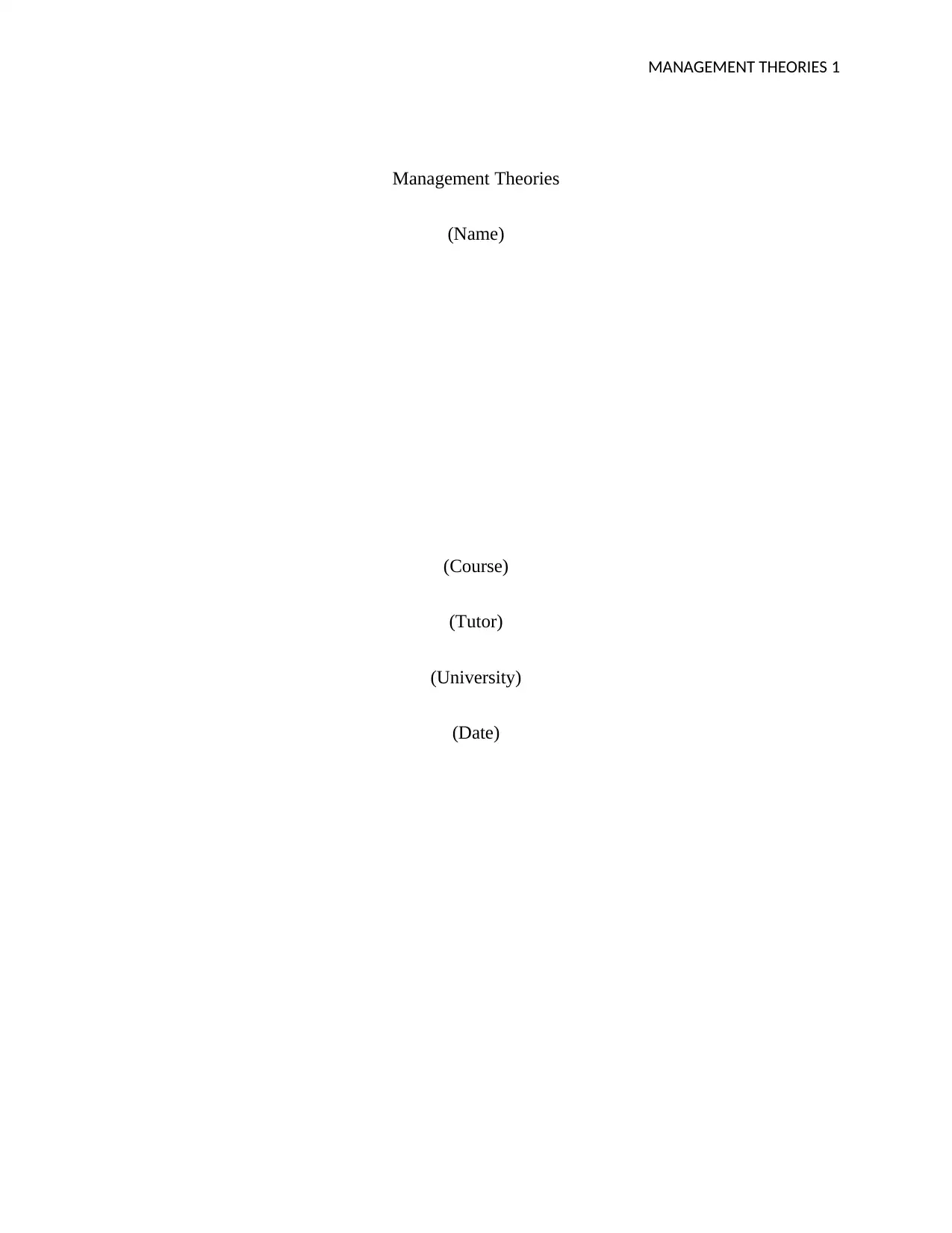
MANAGEMENT THEORIES 1
Management Theories
(Name)
(Course)
(Tutor)
(University)
(Date)
Management Theories
(Name)
(Course)
(Tutor)
(University)
(Date)
Paraphrase This Document
Need a fresh take? Get an instant paraphrase of this document with our AI Paraphraser
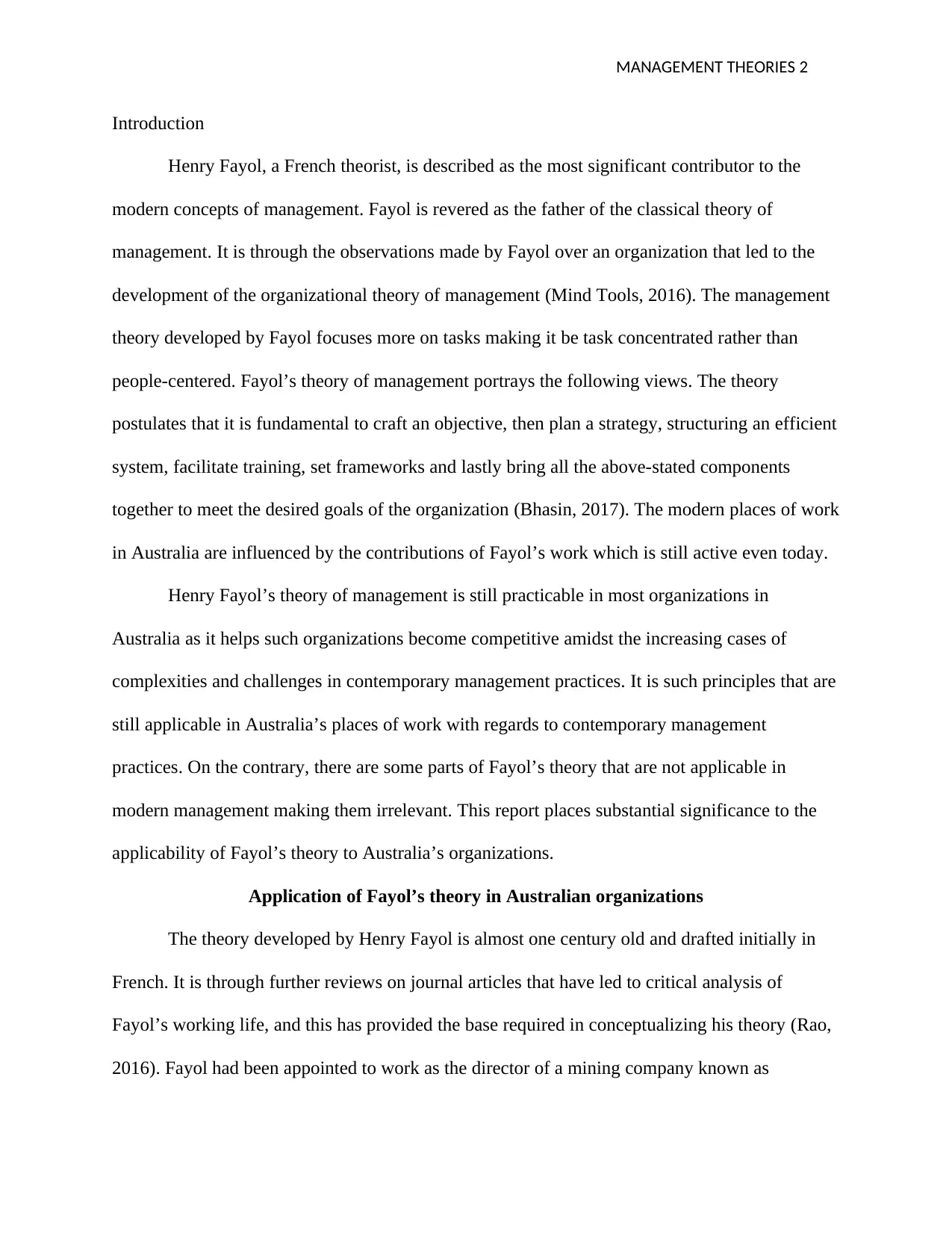
MANAGEMENT THEORIES 2
Introduction
Henry Fayol, a French theorist, is described as the most significant contributor to the
modern concepts of management. Fayol is revered as the father of the classical theory of
management. It is through the observations made by Fayol over an organization that led to the
development of the organizational theory of management (Mind Tools, 2016). The management
theory developed by Fayol focuses more on tasks making it be task concentrated rather than
people-centered. Fayol’s theory of management portrays the following views. The theory
postulates that it is fundamental to craft an objective, then plan a strategy, structuring an efficient
system, facilitate training, set frameworks and lastly bring all the above-stated components
together to meet the desired goals of the organization (Bhasin, 2017). The modern places of work
in Australia are influenced by the contributions of Fayol’s work which is still active even today.
Henry Fayol’s theory of management is still practicable in most organizations in
Australia as it helps such organizations become competitive amidst the increasing cases of
complexities and challenges in contemporary management practices. It is such principles that are
still applicable in Australia’s places of work with regards to contemporary management
practices. On the contrary, there are some parts of Fayol’s theory that are not applicable in
modern management making them irrelevant. This report places substantial significance to the
applicability of Fayol’s theory to Australia’s organizations.
Application of Fayol’s theory in Australian organizations
The theory developed by Henry Fayol is almost one century old and drafted initially in
French. It is through further reviews on journal articles that have led to critical analysis of
Fayol’s working life, and this has provided the base required in conceptualizing his theory (Rao,
2016). Fayol had been appointed to work as the director of a mining company known as
Introduction
Henry Fayol, a French theorist, is described as the most significant contributor to the
modern concepts of management. Fayol is revered as the father of the classical theory of
management. It is through the observations made by Fayol over an organization that led to the
development of the organizational theory of management (Mind Tools, 2016). The management
theory developed by Fayol focuses more on tasks making it be task concentrated rather than
people-centered. Fayol’s theory of management portrays the following views. The theory
postulates that it is fundamental to craft an objective, then plan a strategy, structuring an efficient
system, facilitate training, set frameworks and lastly bring all the above-stated components
together to meet the desired goals of the organization (Bhasin, 2017). The modern places of work
in Australia are influenced by the contributions of Fayol’s work which is still active even today.
Henry Fayol’s theory of management is still practicable in most organizations in
Australia as it helps such organizations become competitive amidst the increasing cases of
complexities and challenges in contemporary management practices. It is such principles that are
still applicable in Australia’s places of work with regards to contemporary management
practices. On the contrary, there are some parts of Fayol’s theory that are not applicable in
modern management making them irrelevant. This report places substantial significance to the
applicability of Fayol’s theory to Australia’s organizations.
Application of Fayol’s theory in Australian organizations
The theory developed by Henry Fayol is almost one century old and drafted initially in
French. It is through further reviews on journal articles that have led to critical analysis of
Fayol’s working life, and this has provided the base required in conceptualizing his theory (Rao,
2016). Fayol had been appointed to work as the director of a mining company known as
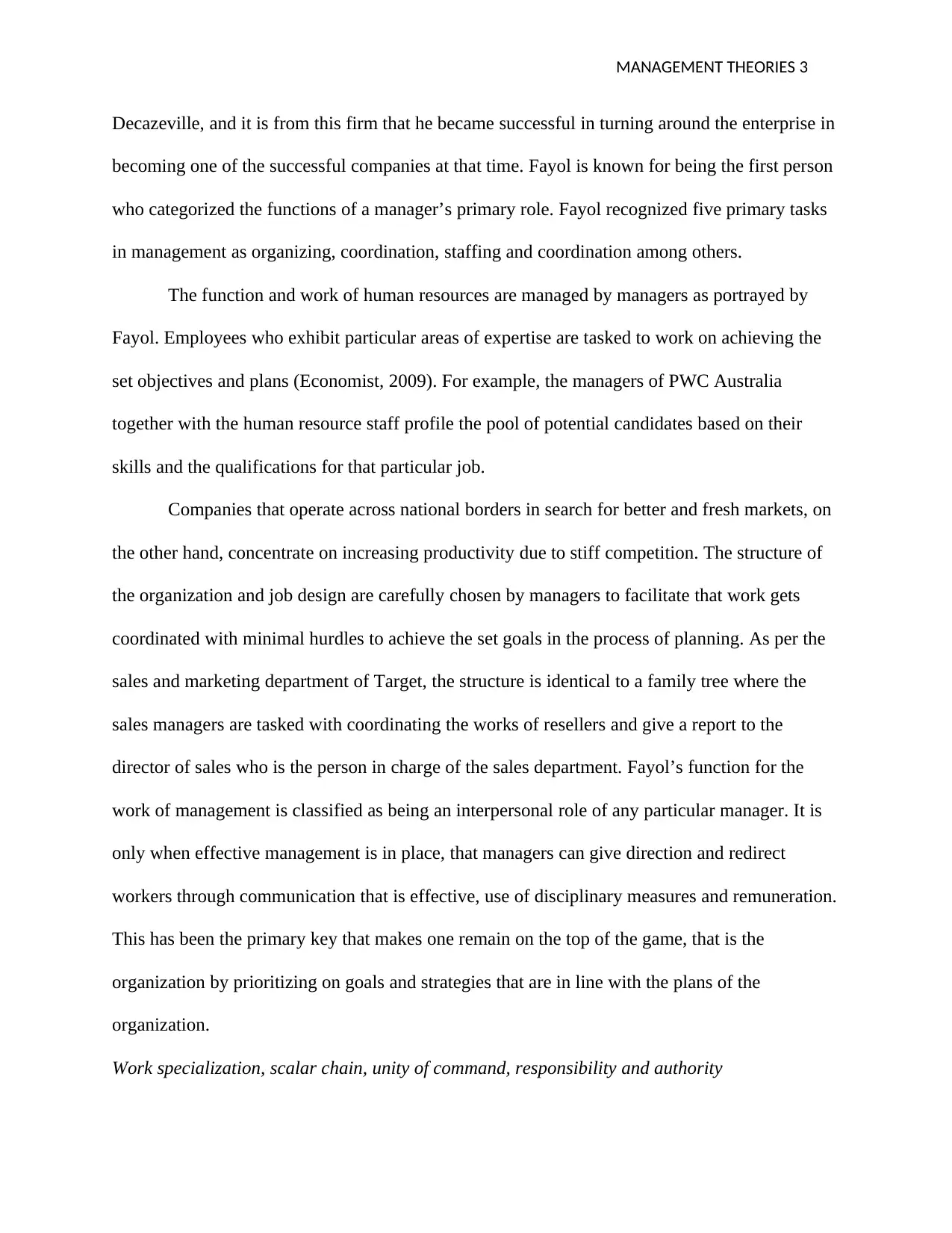
MANAGEMENT THEORIES 3
Decazeville, and it is from this firm that he became successful in turning around the enterprise in
becoming one of the successful companies at that time. Fayol is known for being the first person
who categorized the functions of a manager’s primary role. Fayol recognized five primary tasks
in management as organizing, coordination, staffing and coordination among others.
The function and work of human resources are managed by managers as portrayed by
Fayol. Employees who exhibit particular areas of expertise are tasked to work on achieving the
set objectives and plans (Economist, 2009). For example, the managers of PWC Australia
together with the human resource staff profile the pool of potential candidates based on their
skills and the qualifications for that particular job.
Companies that operate across national borders in search for better and fresh markets, on
the other hand, concentrate on increasing productivity due to stiff competition. The structure of
the organization and job design are carefully chosen by managers to facilitate that work gets
coordinated with minimal hurdles to achieve the set goals in the process of planning. As per the
sales and marketing department of Target, the structure is identical to a family tree where the
sales managers are tasked with coordinating the works of resellers and give a report to the
director of sales who is the person in charge of the sales department. Fayol’s function for the
work of management is classified as being an interpersonal role of any particular manager. It is
only when effective management is in place, that managers can give direction and redirect
workers through communication that is effective, use of disciplinary measures and remuneration.
This has been the primary key that makes one remain on the top of the game, that is the
organization by prioritizing on goals and strategies that are in line with the plans of the
organization.
Work specialization, scalar chain, unity of command, responsibility and authority
Decazeville, and it is from this firm that he became successful in turning around the enterprise in
becoming one of the successful companies at that time. Fayol is known for being the first person
who categorized the functions of a manager’s primary role. Fayol recognized five primary tasks
in management as organizing, coordination, staffing and coordination among others.
The function and work of human resources are managed by managers as portrayed by
Fayol. Employees who exhibit particular areas of expertise are tasked to work on achieving the
set objectives and plans (Economist, 2009). For example, the managers of PWC Australia
together with the human resource staff profile the pool of potential candidates based on their
skills and the qualifications for that particular job.
Companies that operate across national borders in search for better and fresh markets, on
the other hand, concentrate on increasing productivity due to stiff competition. The structure of
the organization and job design are carefully chosen by managers to facilitate that work gets
coordinated with minimal hurdles to achieve the set goals in the process of planning. As per the
sales and marketing department of Target, the structure is identical to a family tree where the
sales managers are tasked with coordinating the works of resellers and give a report to the
director of sales who is the person in charge of the sales department. Fayol’s function for the
work of management is classified as being an interpersonal role of any particular manager. It is
only when effective management is in place, that managers can give direction and redirect
workers through communication that is effective, use of disciplinary measures and remuneration.
This has been the primary key that makes one remain on the top of the game, that is the
organization by prioritizing on goals and strategies that are in line with the plans of the
organization.
Work specialization, scalar chain, unity of command, responsibility and authority
⊘ This is a preview!⊘
Do you want full access?
Subscribe today to unlock all pages.

Trusted by 1+ million students worldwide
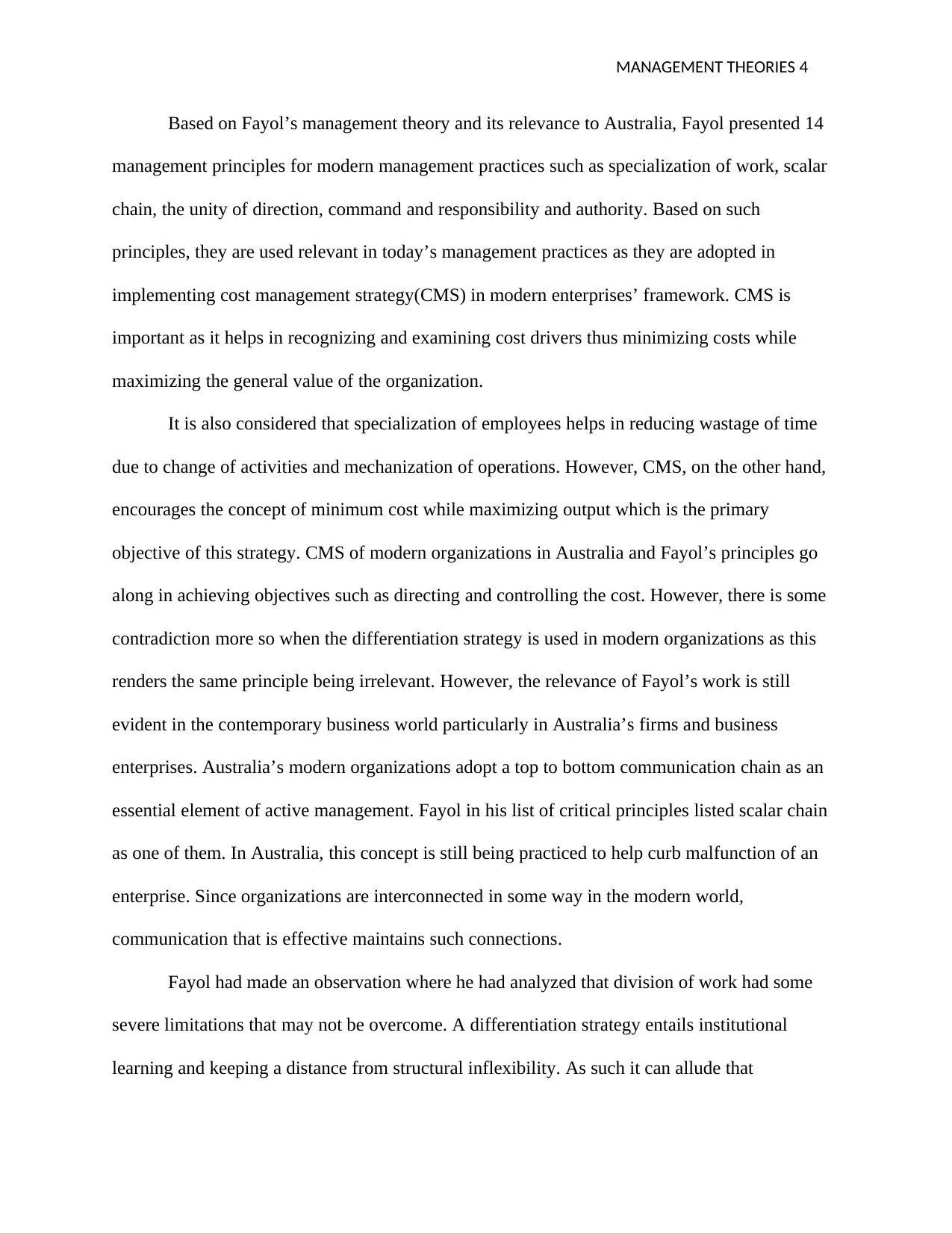
MANAGEMENT THEORIES 4
Based on Fayol’s management theory and its relevance to Australia, Fayol presented 14
management principles for modern management practices such as specialization of work, scalar
chain, the unity of direction, command and responsibility and authority. Based on such
principles, they are used relevant in today’s management practices as they are adopted in
implementing cost management strategy(CMS) in modern enterprises’ framework. CMS is
important as it helps in recognizing and examining cost drivers thus minimizing costs while
maximizing the general value of the organization.
It is also considered that specialization of employees helps in reducing wastage of time
due to change of activities and mechanization of operations. However, CMS, on the other hand,
encourages the concept of minimum cost while maximizing output which is the primary
objective of this strategy. CMS of modern organizations in Australia and Fayol’s principles go
along in achieving objectives such as directing and controlling the cost. However, there is some
contradiction more so when the differentiation strategy is used in modern organizations as this
renders the same principle being irrelevant. However, the relevance of Fayol’s work is still
evident in the contemporary business world particularly in Australia’s firms and business
enterprises. Australia’s modern organizations adopt a top to bottom communication chain as an
essential element of active management. Fayol in his list of critical principles listed scalar chain
as one of them. In Australia, this concept is still being practiced to help curb malfunction of an
enterprise. Since organizations are interconnected in some way in the modern world,
communication that is effective maintains such connections.
Fayol had made an observation where he had analyzed that division of work had some
severe limitations that may not be overcome. A differentiation strategy entails institutional
learning and keeping a distance from structural inflexibility. As such it can allude that
Based on Fayol’s management theory and its relevance to Australia, Fayol presented 14
management principles for modern management practices such as specialization of work, scalar
chain, the unity of direction, command and responsibility and authority. Based on such
principles, they are used relevant in today’s management practices as they are adopted in
implementing cost management strategy(CMS) in modern enterprises’ framework. CMS is
important as it helps in recognizing and examining cost drivers thus minimizing costs while
maximizing the general value of the organization.
It is also considered that specialization of employees helps in reducing wastage of time
due to change of activities and mechanization of operations. However, CMS, on the other hand,
encourages the concept of minimum cost while maximizing output which is the primary
objective of this strategy. CMS of modern organizations in Australia and Fayol’s principles go
along in achieving objectives such as directing and controlling the cost. However, there is some
contradiction more so when the differentiation strategy is used in modern organizations as this
renders the same principle being irrelevant. However, the relevance of Fayol’s work is still
evident in the contemporary business world particularly in Australia’s firms and business
enterprises. Australia’s modern organizations adopt a top to bottom communication chain as an
essential element of active management. Fayol in his list of critical principles listed scalar chain
as one of them. In Australia, this concept is still being practiced to help curb malfunction of an
enterprise. Since organizations are interconnected in some way in the modern world,
communication that is effective maintains such connections.
Fayol had made an observation where he had analyzed that division of work had some
severe limitations that may not be overcome. A differentiation strategy entails institutional
learning and keeping a distance from structural inflexibility. As such it can allude that
Paraphrase This Document
Need a fresh take? Get an instant paraphrase of this document with our AI Paraphraser
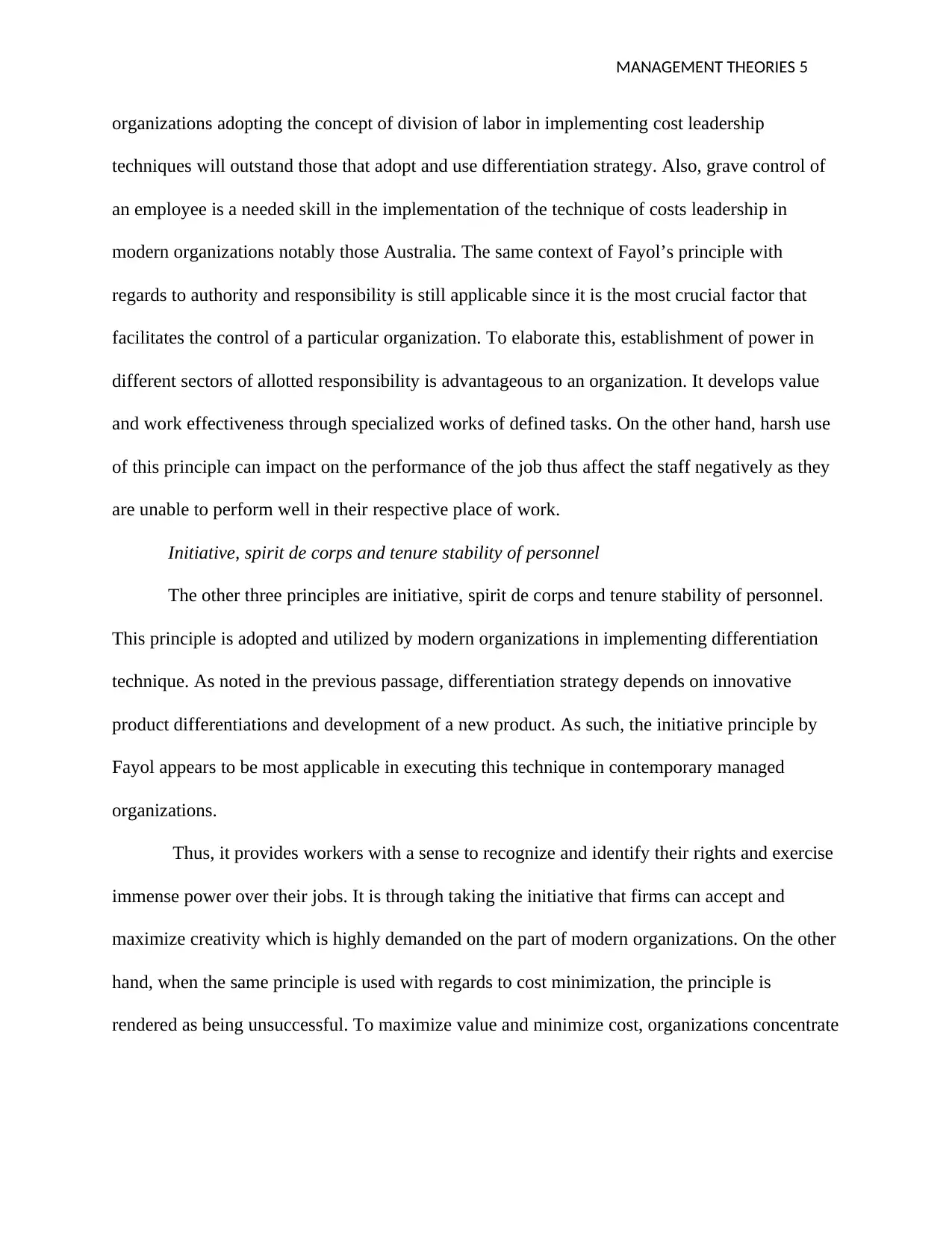
MANAGEMENT THEORIES 5
organizations adopting the concept of division of labor in implementing cost leadership
techniques will outstand those that adopt and use differentiation strategy. Also, grave control of
an employee is a needed skill in the implementation of the technique of costs leadership in
modern organizations notably those Australia. The same context of Fayol’s principle with
regards to authority and responsibility is still applicable since it is the most crucial factor that
facilitates the control of a particular organization. To elaborate this, establishment of power in
different sectors of allotted responsibility is advantageous to an organization. It develops value
and work effectiveness through specialized works of defined tasks. On the other hand, harsh use
of this principle can impact on the performance of the job thus affect the staff negatively as they
are unable to perform well in their respective place of work.
Initiative, spirit de corps and tenure stability of personnel
The other three principles are initiative, spirit de corps and tenure stability of personnel.
This principle is adopted and utilized by modern organizations in implementing differentiation
technique. As noted in the previous passage, differentiation strategy depends on innovative
product differentiations and development of a new product. As such, the initiative principle by
Fayol appears to be most applicable in executing this technique in contemporary managed
organizations.
Thus, it provides workers with a sense to recognize and identify their rights and exercise
immense power over their jobs. It is through taking the initiative that firms can accept and
maximize creativity which is highly demanded on the part of modern organizations. On the other
hand, when the same principle is used with regards to cost minimization, the principle is
rendered as being unsuccessful. To maximize value and minimize cost, organizations concentrate
organizations adopting the concept of division of labor in implementing cost leadership
techniques will outstand those that adopt and use differentiation strategy. Also, grave control of
an employee is a needed skill in the implementation of the technique of costs leadership in
modern organizations notably those Australia. The same context of Fayol’s principle with
regards to authority and responsibility is still applicable since it is the most crucial factor that
facilitates the control of a particular organization. To elaborate this, establishment of power in
different sectors of allotted responsibility is advantageous to an organization. It develops value
and work effectiveness through specialized works of defined tasks. On the other hand, harsh use
of this principle can impact on the performance of the job thus affect the staff negatively as they
are unable to perform well in their respective place of work.
Initiative, spirit de corps and tenure stability of personnel
The other three principles are initiative, spirit de corps and tenure stability of personnel.
This principle is adopted and utilized by modern organizations in implementing differentiation
technique. As noted in the previous passage, differentiation strategy depends on innovative
product differentiations and development of a new product. As such, the initiative principle by
Fayol appears to be most applicable in executing this technique in contemporary managed
organizations.
Thus, it provides workers with a sense to recognize and identify their rights and exercise
immense power over their jobs. It is through taking the initiative that firms can accept and
maximize creativity which is highly demanded on the part of modern organizations. On the other
hand, when the same principle is used with regards to cost minimization, the principle is
rendered as being unsuccessful. To maximize value and minimize cost, organizations concentrate
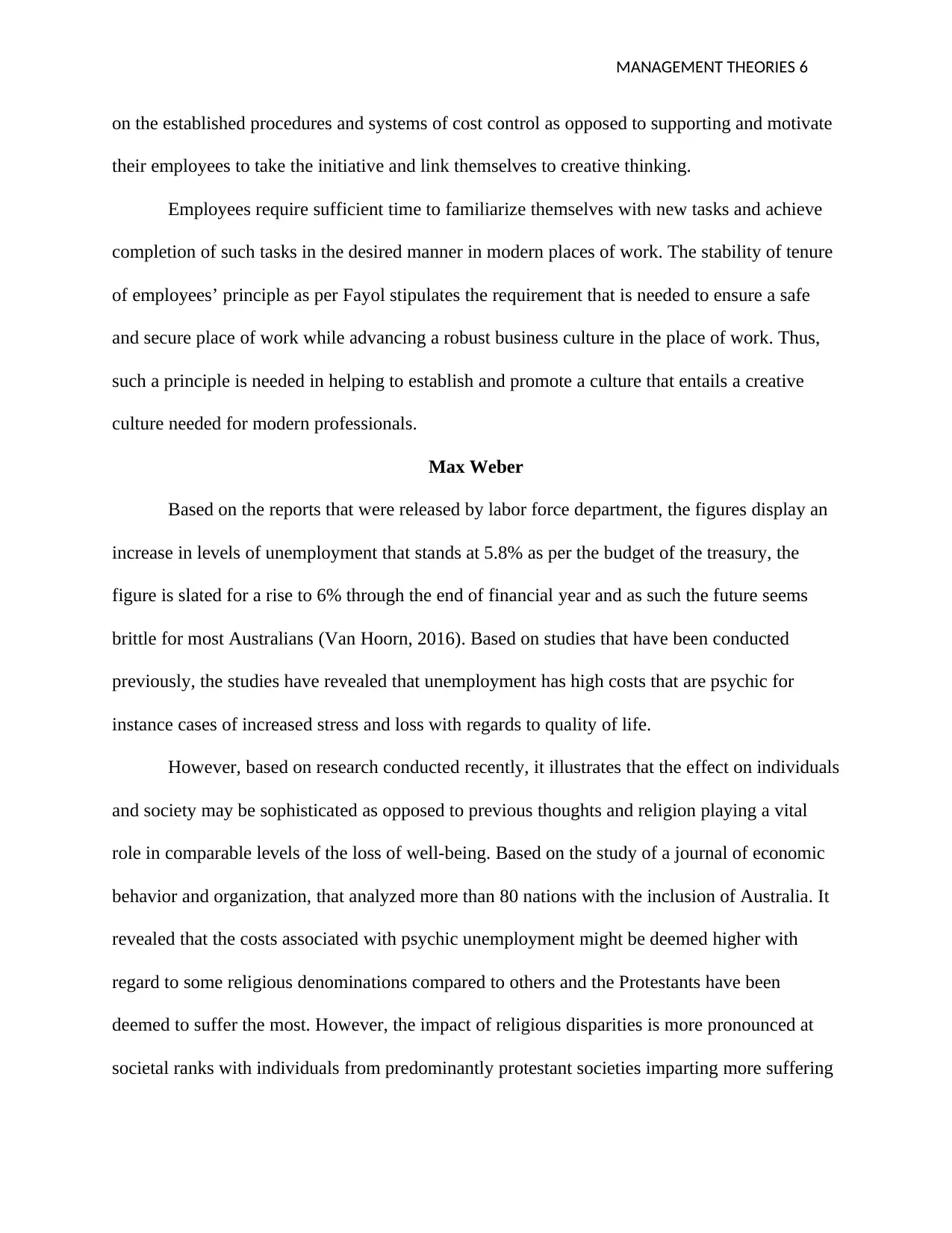
MANAGEMENT THEORIES 6
on the established procedures and systems of cost control as opposed to supporting and motivate
their employees to take the initiative and link themselves to creative thinking.
Employees require sufficient time to familiarize themselves with new tasks and achieve
completion of such tasks in the desired manner in modern places of work. The stability of tenure
of employees’ principle as per Fayol stipulates the requirement that is needed to ensure a safe
and secure place of work while advancing a robust business culture in the place of work. Thus,
such a principle is needed in helping to establish and promote a culture that entails a creative
culture needed for modern professionals.
Max Weber
Based on the reports that were released by labor force department, the figures display an
increase in levels of unemployment that stands at 5.8% as per the budget of the treasury, the
figure is slated for a rise to 6% through the end of financial year and as such the future seems
brittle for most Australians (Van Hoorn, 2016). Based on studies that have been conducted
previously, the studies have revealed that unemployment has high costs that are psychic for
instance cases of increased stress and loss with regards to quality of life.
However, based on research conducted recently, it illustrates that the effect on individuals
and society may be sophisticated as opposed to previous thoughts and religion playing a vital
role in comparable levels of the loss of well-being. Based on the study of a journal of economic
behavior and organization, that analyzed more than 80 nations with the inclusion of Australia. It
revealed that the costs associated with psychic unemployment might be deemed higher with
regard to some religious denominations compared to others and the Protestants have been
deemed to suffer the most. However, the impact of religious disparities is more pronounced at
societal ranks with individuals from predominantly protestant societies imparting more suffering
on the established procedures and systems of cost control as opposed to supporting and motivate
their employees to take the initiative and link themselves to creative thinking.
Employees require sufficient time to familiarize themselves with new tasks and achieve
completion of such tasks in the desired manner in modern places of work. The stability of tenure
of employees’ principle as per Fayol stipulates the requirement that is needed to ensure a safe
and secure place of work while advancing a robust business culture in the place of work. Thus,
such a principle is needed in helping to establish and promote a culture that entails a creative
culture needed for modern professionals.
Max Weber
Based on the reports that were released by labor force department, the figures display an
increase in levels of unemployment that stands at 5.8% as per the budget of the treasury, the
figure is slated for a rise to 6% through the end of financial year and as such the future seems
brittle for most Australians (Van Hoorn, 2016). Based on studies that have been conducted
previously, the studies have revealed that unemployment has high costs that are psychic for
instance cases of increased stress and loss with regards to quality of life.
However, based on research conducted recently, it illustrates that the effect on individuals
and society may be sophisticated as opposed to previous thoughts and religion playing a vital
role in comparable levels of the loss of well-being. Based on the study of a journal of economic
behavior and organization, that analyzed more than 80 nations with the inclusion of Australia. It
revealed that the costs associated with psychic unemployment might be deemed higher with
regard to some religious denominations compared to others and the Protestants have been
deemed to suffer the most. However, the impact of religious disparities is more pronounced at
societal ranks with individuals from predominantly protestant societies imparting more suffering
⊘ This is a preview!⊘
Do you want full access?
Subscribe today to unlock all pages.

Trusted by 1+ million students worldwide
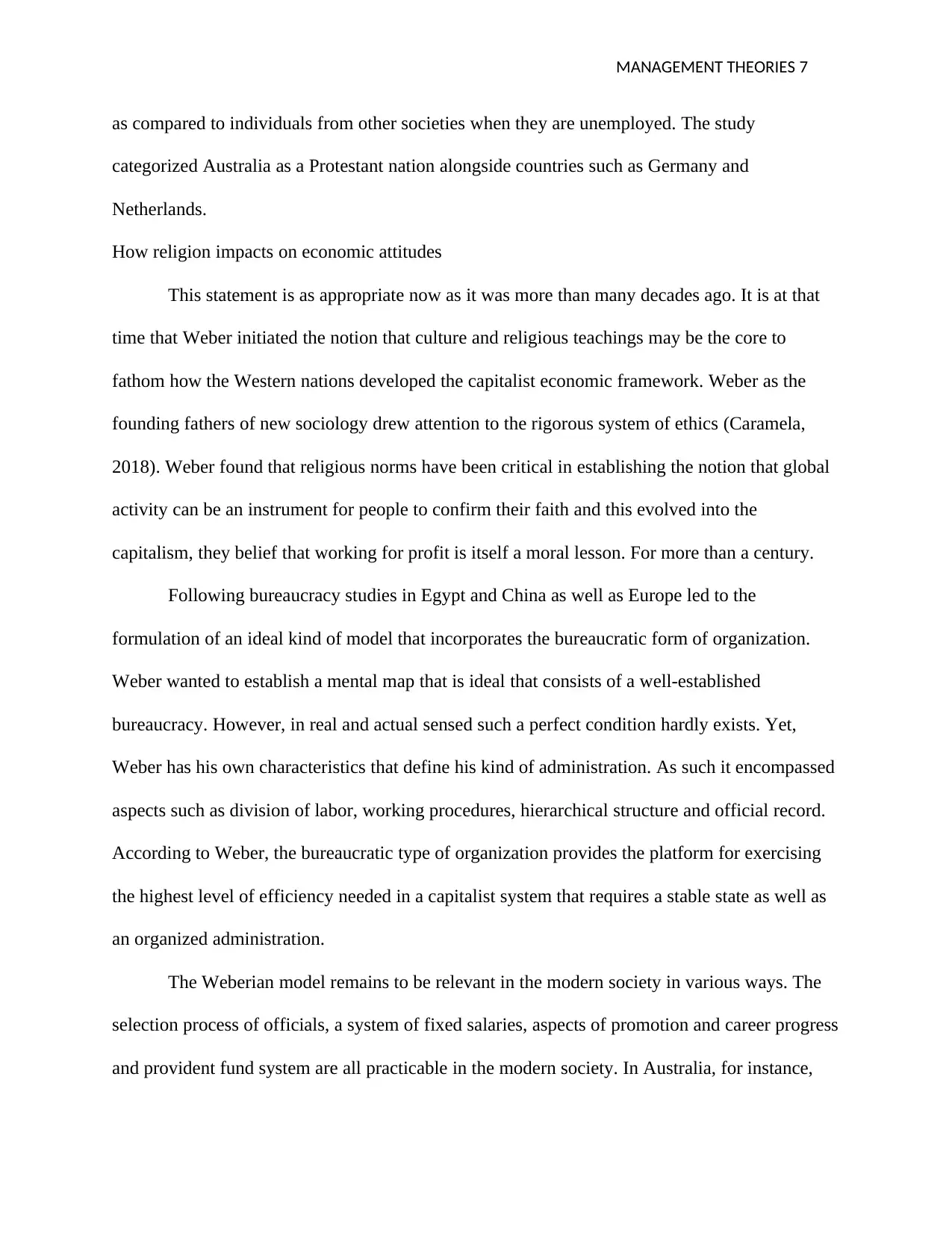
MANAGEMENT THEORIES 7
as compared to individuals from other societies when they are unemployed. The study
categorized Australia as a Protestant nation alongside countries such as Germany and
Netherlands.
How religion impacts on economic attitudes
This statement is as appropriate now as it was more than many decades ago. It is at that
time that Weber initiated the notion that culture and religious teachings may be the core to
fathom how the Western nations developed the capitalist economic framework. Weber as the
founding fathers of new sociology drew attention to the rigorous system of ethics (Caramela,
2018). Weber found that religious norms have been critical in establishing the notion that global
activity can be an instrument for people to confirm their faith and this evolved into the
capitalism, they belief that working for profit is itself a moral lesson. For more than a century.
Following bureaucracy studies in Egypt and China as well as Europe led to the
formulation of an ideal kind of model that incorporates the bureaucratic form of organization.
Weber wanted to establish a mental map that is ideal that consists of a well-established
bureaucracy. However, in real and actual sensed such a perfect condition hardly exists. Yet,
Weber has his own characteristics that define his kind of administration. As such it encompassed
aspects such as division of labor, working procedures, hierarchical structure and official record.
According to Weber, the bureaucratic type of organization provides the platform for exercising
the highest level of efficiency needed in a capitalist system that requires a stable state as well as
an organized administration.
The Weberian model remains to be relevant in the modern society in various ways. The
selection process of officials, a system of fixed salaries, aspects of promotion and career progress
and provident fund system are all practicable in the modern society. In Australia, for instance,
as compared to individuals from other societies when they are unemployed. The study
categorized Australia as a Protestant nation alongside countries such as Germany and
Netherlands.
How religion impacts on economic attitudes
This statement is as appropriate now as it was more than many decades ago. It is at that
time that Weber initiated the notion that culture and religious teachings may be the core to
fathom how the Western nations developed the capitalist economic framework. Weber as the
founding fathers of new sociology drew attention to the rigorous system of ethics (Caramela,
2018). Weber found that religious norms have been critical in establishing the notion that global
activity can be an instrument for people to confirm their faith and this evolved into the
capitalism, they belief that working for profit is itself a moral lesson. For more than a century.
Following bureaucracy studies in Egypt and China as well as Europe led to the
formulation of an ideal kind of model that incorporates the bureaucratic form of organization.
Weber wanted to establish a mental map that is ideal that consists of a well-established
bureaucracy. However, in real and actual sensed such a perfect condition hardly exists. Yet,
Weber has his own characteristics that define his kind of administration. As such it encompassed
aspects such as division of labor, working procedures, hierarchical structure and official record.
According to Weber, the bureaucratic type of organization provides the platform for exercising
the highest level of efficiency needed in a capitalist system that requires a stable state as well as
an organized administration.
The Weberian model remains to be relevant in the modern society in various ways. The
selection process of officials, a system of fixed salaries, aspects of promotion and career progress
and provident fund system are all practicable in the modern society. In Australia, for instance,
Paraphrase This Document
Need a fresh take? Get an instant paraphrase of this document with our AI Paraphraser
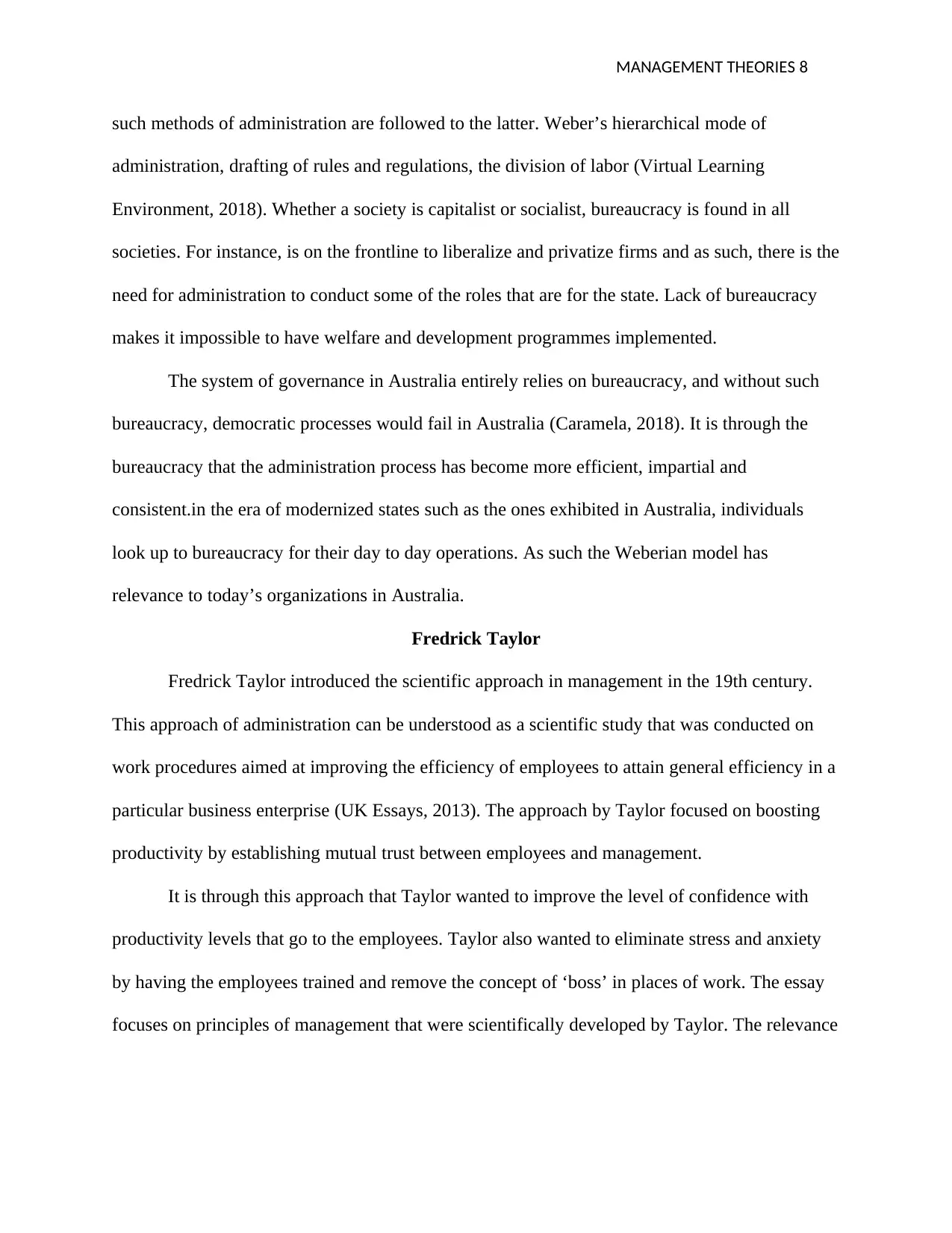
MANAGEMENT THEORIES 8
such methods of administration are followed to the latter. Weber’s hierarchical mode of
administration, drafting of rules and regulations, the division of labor (Virtual Learning
Environment, 2018). Whether a society is capitalist or socialist, bureaucracy is found in all
societies. For instance, is on the frontline to liberalize and privatize firms and as such, there is the
need for administration to conduct some of the roles that are for the state. Lack of bureaucracy
makes it impossible to have welfare and development programmes implemented.
The system of governance in Australia entirely relies on bureaucracy, and without such
bureaucracy, democratic processes would fail in Australia (Caramela, 2018). It is through the
bureaucracy that the administration process has become more efficient, impartial and
consistent.in the era of modernized states such as the ones exhibited in Australia, individuals
look up to bureaucracy for their day to day operations. As such the Weberian model has
relevance to today’s organizations in Australia.
Fredrick Taylor
Fredrick Taylor introduced the scientific approach in management in the 19th century.
This approach of administration can be understood as a scientific study that was conducted on
work procedures aimed at improving the efficiency of employees to attain general efficiency in a
particular business enterprise (UK Essays, 2013). The approach by Taylor focused on boosting
productivity by establishing mutual trust between employees and management.
It is through this approach that Taylor wanted to improve the level of confidence with
productivity levels that go to the employees. Taylor also wanted to eliminate stress and anxiety
by having the employees trained and remove the concept of ‘boss’ in places of work. The essay
focuses on principles of management that were scientifically developed by Taylor. The relevance
such methods of administration are followed to the latter. Weber’s hierarchical mode of
administration, drafting of rules and regulations, the division of labor (Virtual Learning
Environment, 2018). Whether a society is capitalist or socialist, bureaucracy is found in all
societies. For instance, is on the frontline to liberalize and privatize firms and as such, there is the
need for administration to conduct some of the roles that are for the state. Lack of bureaucracy
makes it impossible to have welfare and development programmes implemented.
The system of governance in Australia entirely relies on bureaucracy, and without such
bureaucracy, democratic processes would fail in Australia (Caramela, 2018). It is through the
bureaucracy that the administration process has become more efficient, impartial and
consistent.in the era of modernized states such as the ones exhibited in Australia, individuals
look up to bureaucracy for their day to day operations. As such the Weberian model has
relevance to today’s organizations in Australia.
Fredrick Taylor
Fredrick Taylor introduced the scientific approach in management in the 19th century.
This approach of administration can be understood as a scientific study that was conducted on
work procedures aimed at improving the efficiency of employees to attain general efficiency in a
particular business enterprise (UK Essays, 2013). The approach by Taylor focused on boosting
productivity by establishing mutual trust between employees and management.
It is through this approach that Taylor wanted to improve the level of confidence with
productivity levels that go to the employees. Taylor also wanted to eliminate stress and anxiety
by having the employees trained and remove the concept of ‘boss’ in places of work. The essay
focuses on principles of management that were scientifically developed by Taylor. The relevance
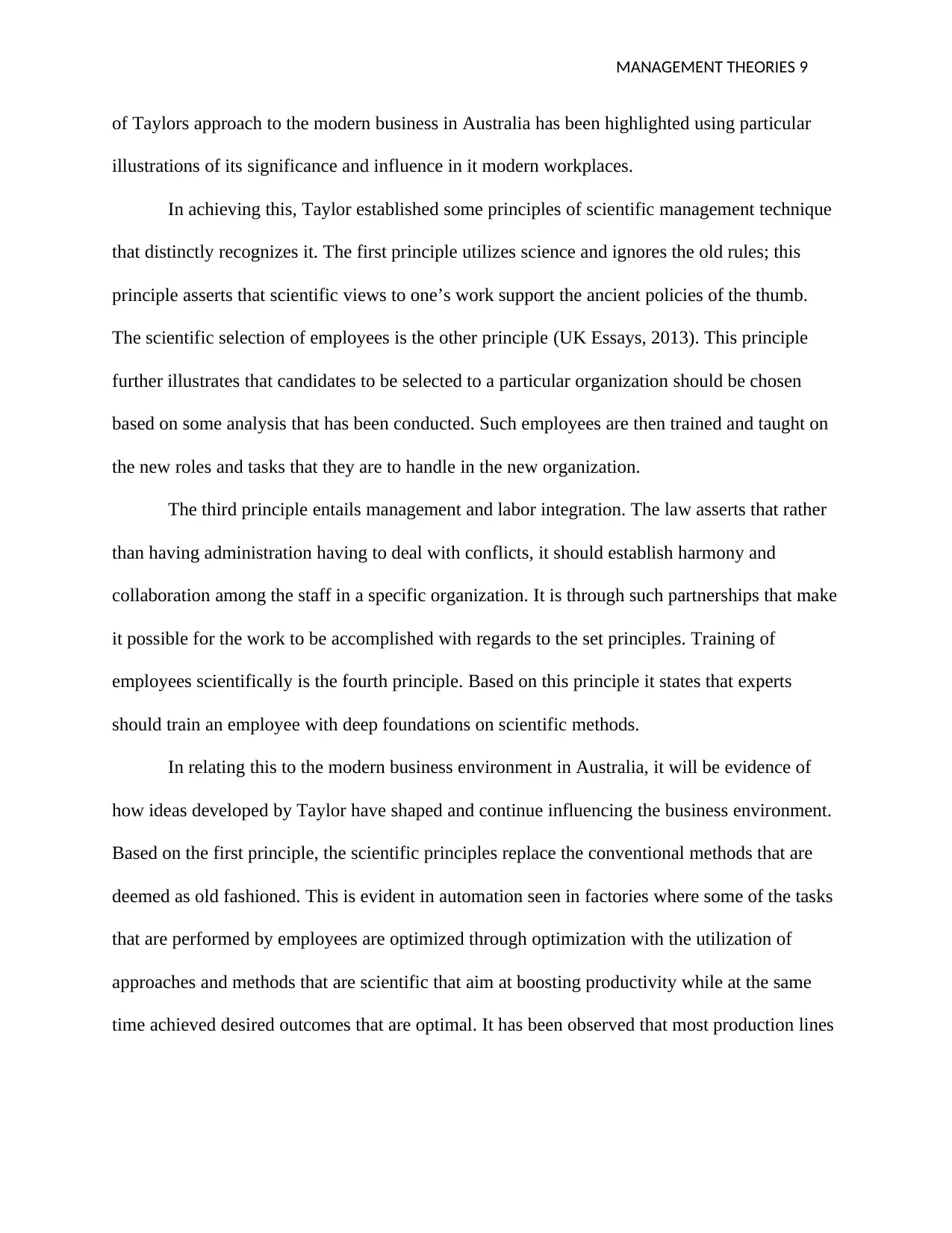
MANAGEMENT THEORIES 9
of Taylors approach to the modern business in Australia has been highlighted using particular
illustrations of its significance and influence in it modern workplaces.
In achieving this, Taylor established some principles of scientific management technique
that distinctly recognizes it. The first principle utilizes science and ignores the old rules; this
principle asserts that scientific views to one’s work support the ancient policies of the thumb.
The scientific selection of employees is the other principle (UK Essays, 2013). This principle
further illustrates that candidates to be selected to a particular organization should be chosen
based on some analysis that has been conducted. Such employees are then trained and taught on
the new roles and tasks that they are to handle in the new organization.
The third principle entails management and labor integration. The law asserts that rather
than having administration having to deal with conflicts, it should establish harmony and
collaboration among the staff in a specific organization. It is through such partnerships that make
it possible for the work to be accomplished with regards to the set principles. Training of
employees scientifically is the fourth principle. Based on this principle it states that experts
should train an employee with deep foundations on scientific methods.
In relating this to the modern business environment in Australia, it will be evidence of
how ideas developed by Taylor have shaped and continue influencing the business environment.
Based on the first principle, the scientific principles replace the conventional methods that are
deemed as old fashioned. This is evident in automation seen in factories where some of the tasks
that are performed by employees are optimized through optimization with the utilization of
approaches and methods that are scientific that aim at boosting productivity while at the same
time achieved desired outcomes that are optimal. It has been observed that most production lines
of Taylors approach to the modern business in Australia has been highlighted using particular
illustrations of its significance and influence in it modern workplaces.
In achieving this, Taylor established some principles of scientific management technique
that distinctly recognizes it. The first principle utilizes science and ignores the old rules; this
principle asserts that scientific views to one’s work support the ancient policies of the thumb.
The scientific selection of employees is the other principle (UK Essays, 2013). This principle
further illustrates that candidates to be selected to a particular organization should be chosen
based on some analysis that has been conducted. Such employees are then trained and taught on
the new roles and tasks that they are to handle in the new organization.
The third principle entails management and labor integration. The law asserts that rather
than having administration having to deal with conflicts, it should establish harmony and
collaboration among the staff in a specific organization. It is through such partnerships that make
it possible for the work to be accomplished with regards to the set principles. Training of
employees scientifically is the fourth principle. Based on this principle it states that experts
should train an employee with deep foundations on scientific methods.
In relating this to the modern business environment in Australia, it will be evidence of
how ideas developed by Taylor have shaped and continue influencing the business environment.
Based on the first principle, the scientific principles replace the conventional methods that are
deemed as old fashioned. This is evident in automation seen in factories where some of the tasks
that are performed by employees are optimized through optimization with the utilization of
approaches and methods that are scientific that aim at boosting productivity while at the same
time achieved desired outcomes that are optimal. It has been observed that most production lines
⊘ This is a preview!⊘
Do you want full access?
Subscribe today to unlock all pages.

Trusted by 1+ million students worldwide
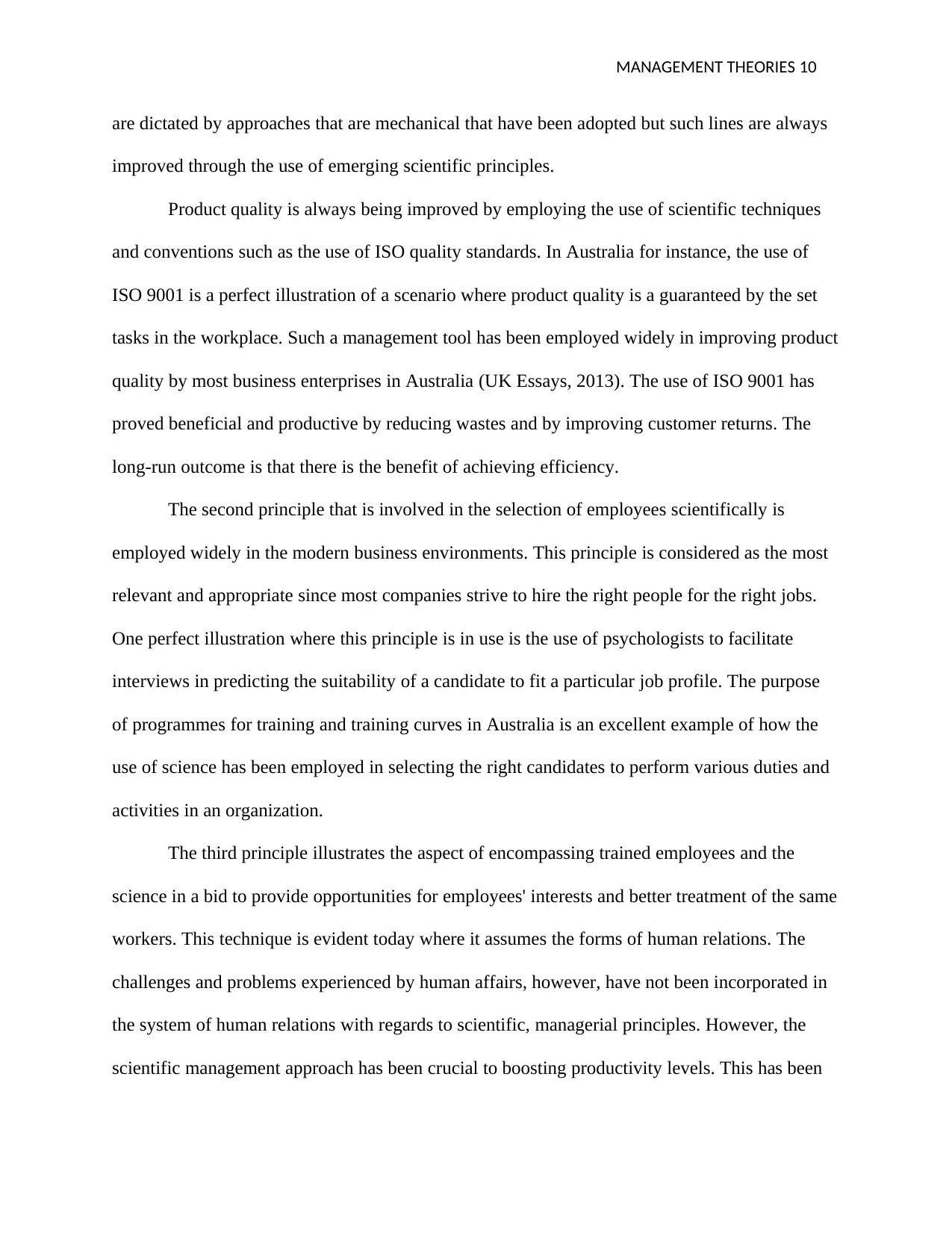
MANAGEMENT THEORIES 10
are dictated by approaches that are mechanical that have been adopted but such lines are always
improved through the use of emerging scientific principles.
Product quality is always being improved by employing the use of scientific techniques
and conventions such as the use of ISO quality standards. In Australia for instance, the use of
ISO 9001 is a perfect illustration of a scenario where product quality is a guaranteed by the set
tasks in the workplace. Such a management tool has been employed widely in improving product
quality by most business enterprises in Australia (UK Essays, 2013). The use of ISO 9001 has
proved beneficial and productive by reducing wastes and by improving customer returns. The
long-run outcome is that there is the benefit of achieving efficiency.
The second principle that is involved in the selection of employees scientifically is
employed widely in the modern business environments. This principle is considered as the most
relevant and appropriate since most companies strive to hire the right people for the right jobs.
One perfect illustration where this principle is in use is the use of psychologists to facilitate
interviews in predicting the suitability of a candidate to fit a particular job profile. The purpose
of programmes for training and training curves in Australia is an excellent example of how the
use of science has been employed in selecting the right candidates to perform various duties and
activities in an organization.
The third principle illustrates the aspect of encompassing trained employees and the
science in a bid to provide opportunities for employees' interests and better treatment of the same
workers. This technique is evident today where it assumes the forms of human relations. The
challenges and problems experienced by human affairs, however, have not been incorporated in
the system of human relations with regards to scientific, managerial principles. However, the
scientific management approach has been crucial to boosting productivity levels. This has been
are dictated by approaches that are mechanical that have been adopted but such lines are always
improved through the use of emerging scientific principles.
Product quality is always being improved by employing the use of scientific techniques
and conventions such as the use of ISO quality standards. In Australia for instance, the use of
ISO 9001 is a perfect illustration of a scenario where product quality is a guaranteed by the set
tasks in the workplace. Such a management tool has been employed widely in improving product
quality by most business enterprises in Australia (UK Essays, 2013). The use of ISO 9001 has
proved beneficial and productive by reducing wastes and by improving customer returns. The
long-run outcome is that there is the benefit of achieving efficiency.
The second principle that is involved in the selection of employees scientifically is
employed widely in the modern business environments. This principle is considered as the most
relevant and appropriate since most companies strive to hire the right people for the right jobs.
One perfect illustration where this principle is in use is the use of psychologists to facilitate
interviews in predicting the suitability of a candidate to fit a particular job profile. The purpose
of programmes for training and training curves in Australia is an excellent example of how the
use of science has been employed in selecting the right candidates to perform various duties and
activities in an organization.
The third principle illustrates the aspect of encompassing trained employees and the
science in a bid to provide opportunities for employees' interests and better treatment of the same
workers. This technique is evident today where it assumes the forms of human relations. The
challenges and problems experienced by human affairs, however, have not been incorporated in
the system of human relations with regards to scientific, managerial principles. However, the
scientific management approach has been crucial to boosting productivity levels. This has been
Paraphrase This Document
Need a fresh take? Get an instant paraphrase of this document with our AI Paraphraser
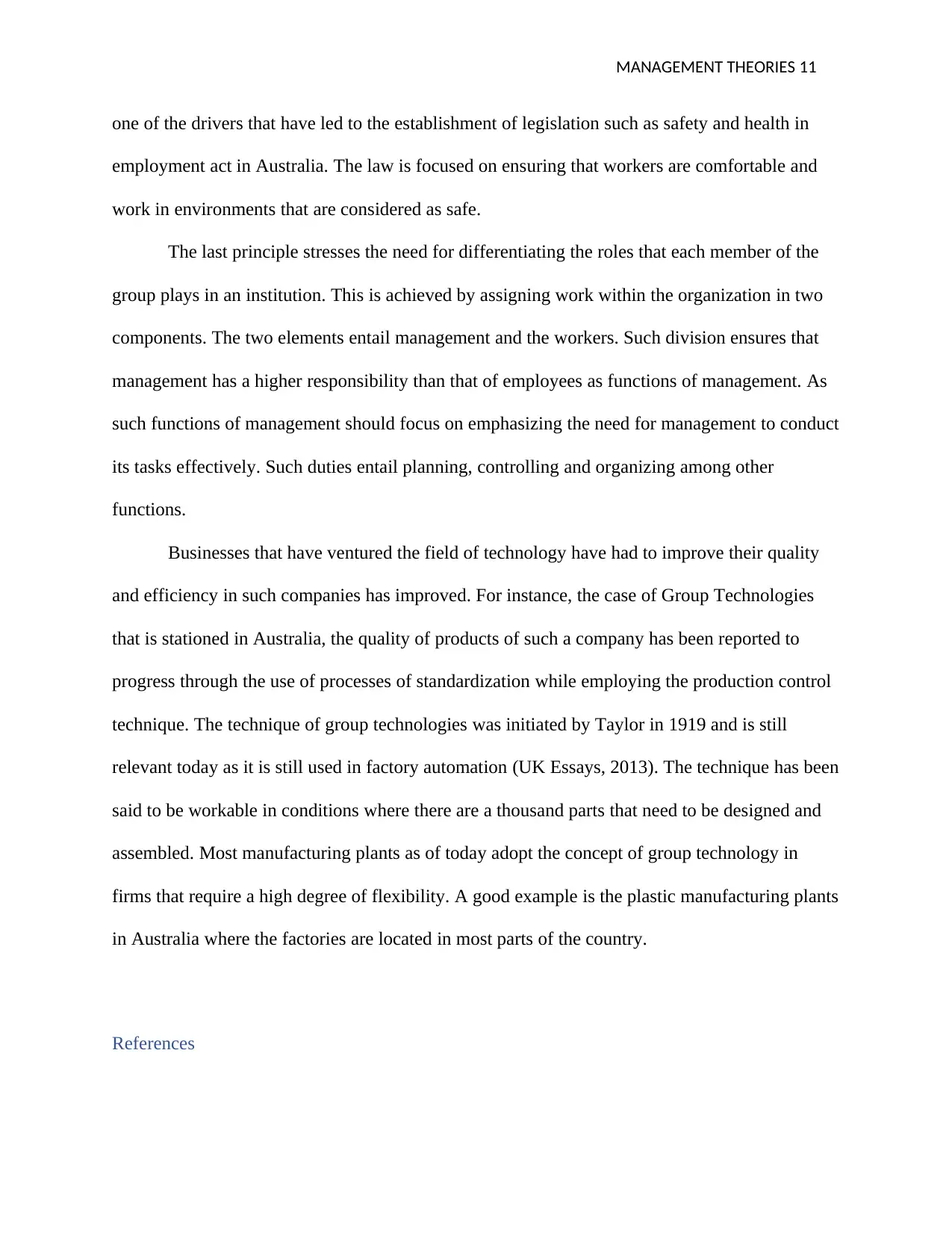
MANAGEMENT THEORIES 11
one of the drivers that have led to the establishment of legislation such as safety and health in
employment act in Australia. The law is focused on ensuring that workers are comfortable and
work in environments that are considered as safe.
The last principle stresses the need for differentiating the roles that each member of the
group plays in an institution. This is achieved by assigning work within the organization in two
components. The two elements entail management and the workers. Such division ensures that
management has a higher responsibility than that of employees as functions of management. As
such functions of management should focus on emphasizing the need for management to conduct
its tasks effectively. Such duties entail planning, controlling and organizing among other
functions.
Businesses that have ventured the field of technology have had to improve their quality
and efficiency in such companies has improved. For instance, the case of Group Technologies
that is stationed in Australia, the quality of products of such a company has been reported to
progress through the use of processes of standardization while employing the production control
technique. The technique of group technologies was initiated by Taylor in 1919 and is still
relevant today as it is still used in factory automation (UK Essays, 2013). The technique has been
said to be workable in conditions where there are a thousand parts that need to be designed and
assembled. Most manufacturing plants as of today adopt the concept of group technology in
firms that require a high degree of flexibility. A good example is the plastic manufacturing plants
in Australia where the factories are located in most parts of the country.
References
one of the drivers that have led to the establishment of legislation such as safety and health in
employment act in Australia. The law is focused on ensuring that workers are comfortable and
work in environments that are considered as safe.
The last principle stresses the need for differentiating the roles that each member of the
group plays in an institution. This is achieved by assigning work within the organization in two
components. The two elements entail management and the workers. Such division ensures that
management has a higher responsibility than that of employees as functions of management. As
such functions of management should focus on emphasizing the need for management to conduct
its tasks effectively. Such duties entail planning, controlling and organizing among other
functions.
Businesses that have ventured the field of technology have had to improve their quality
and efficiency in such companies has improved. For instance, the case of Group Technologies
that is stationed in Australia, the quality of products of such a company has been reported to
progress through the use of processes of standardization while employing the production control
technique. The technique of group technologies was initiated by Taylor in 1919 and is still
relevant today as it is still used in factory automation (UK Essays, 2013). The technique has been
said to be workable in conditions where there are a thousand parts that need to be designed and
assembled. Most manufacturing plants as of today adopt the concept of group technology in
firms that require a high degree of flexibility. A good example is the plastic manufacturing plants
in Australia where the factories are located in most parts of the country.
References
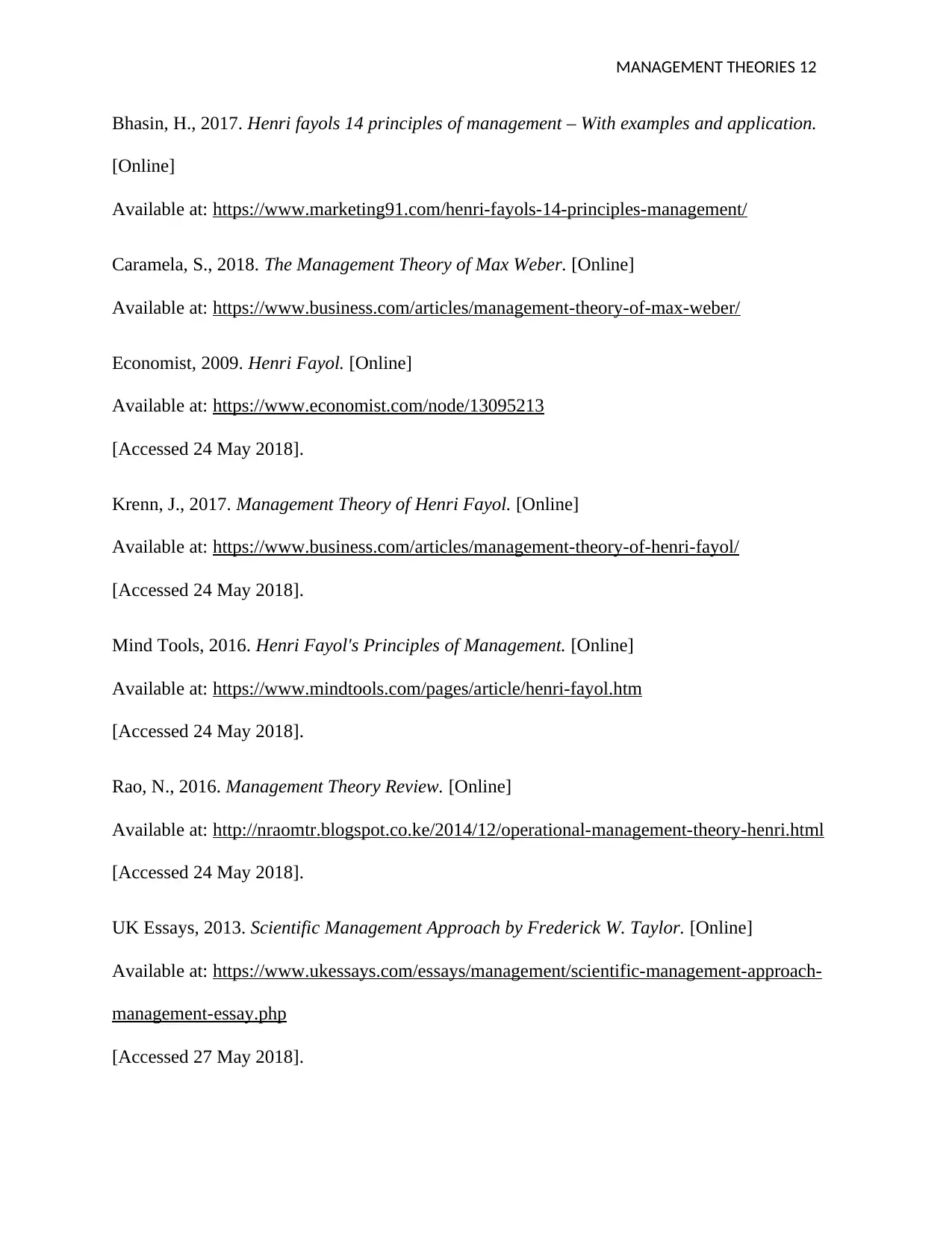
MANAGEMENT THEORIES 12
Bhasin, H., 2017. Henri fayols 14 principles of management – With examples and application.
[Online]
Available at: https://www.marketing91.com/henri-fayols-14-principles-management/
Caramela, S., 2018. The Management Theory of Max Weber. [Online]
Available at: https://www.business.com/articles/management-theory-of-max-weber/
Economist, 2009. Henri Fayol. [Online]
Available at: https://www.economist.com/node/13095213
[Accessed 24 May 2018].
Krenn, J., 2017. Management Theory of Henri Fayol. [Online]
Available at: https://www.business.com/articles/management-theory-of-henri-fayol/
[Accessed 24 May 2018].
Mind Tools, 2016. Henri Fayol's Principles of Management. [Online]
Available at: https://www.mindtools.com/pages/article/henri-fayol.htm
[Accessed 24 May 2018].
Rao, N., 2016. Management Theory Review. [Online]
Available at: http://nraomtr.blogspot.co.ke/2014/12/operational-management-theory-henri.html
[Accessed 24 May 2018].
UK Essays, 2013. Scientific Management Approach by Frederick W. Taylor. [Online]
Available at: https://www.ukessays.com/essays/management/scientific-management-approach-
management-essay.php
[Accessed 27 May 2018].
Bhasin, H., 2017. Henri fayols 14 principles of management – With examples and application.
[Online]
Available at: https://www.marketing91.com/henri-fayols-14-principles-management/
Caramela, S., 2018. The Management Theory of Max Weber. [Online]
Available at: https://www.business.com/articles/management-theory-of-max-weber/
Economist, 2009. Henri Fayol. [Online]
Available at: https://www.economist.com/node/13095213
[Accessed 24 May 2018].
Krenn, J., 2017. Management Theory of Henri Fayol. [Online]
Available at: https://www.business.com/articles/management-theory-of-henri-fayol/
[Accessed 24 May 2018].
Mind Tools, 2016. Henri Fayol's Principles of Management. [Online]
Available at: https://www.mindtools.com/pages/article/henri-fayol.htm
[Accessed 24 May 2018].
Rao, N., 2016. Management Theory Review. [Online]
Available at: http://nraomtr.blogspot.co.ke/2014/12/operational-management-theory-henri.html
[Accessed 24 May 2018].
UK Essays, 2013. Scientific Management Approach by Frederick W. Taylor. [Online]
Available at: https://www.ukessays.com/essays/management/scientific-management-approach-
management-essay.php
[Accessed 27 May 2018].
⊘ This is a preview!⊘
Do you want full access?
Subscribe today to unlock all pages.

Trusted by 1+ million students worldwide
1 out of 17
Related Documents
Your All-in-One AI-Powered Toolkit for Academic Success.
+13062052269
info@desklib.com
Available 24*7 on WhatsApp / Email
![[object Object]](/_next/static/media/star-bottom.7253800d.svg)
Unlock your academic potential
Copyright © 2020–2025 A2Z Services. All Rights Reserved. Developed and managed by ZUCOL.





